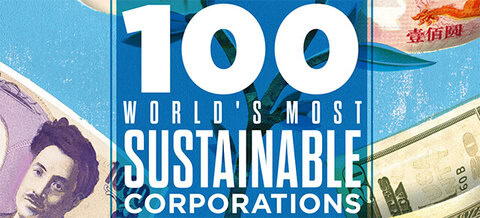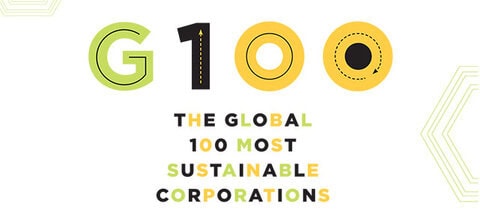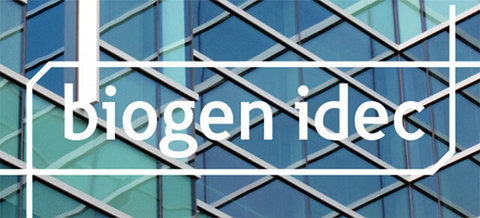Determining which companies are “sustainable” and which are not is a challenging enterprise. Not only is there no single, universally accepted definition of “corporate sustainability," publicly traded companies are exceedingly complex institutions, often spanning multiple geographies and industrial sectors.
Against this backdrop, our approach is simple – we unpackage “corporate sustainability” into its component parts, and stick to the numbers.
Qualifying Global 100 companies are scored on a percent rank basis against their global industry peers on a list of twelve quantitative key performance indicators that run the gamut from energy and water use, to employee compensation and corporate tax strategy.
Because the indicators are quantitative and clearly-defined, the results of the Global 100 are objective and replicable. The Global 100 follows a rules-based construction methodology and is more akin to a financial index than many other “sustainability” indices.
The Global 100 index is maintained by maintained by Corporate Knights research group.
The Global 100 starting universe
All publicly traded companies with a market capitalization of at least US$ 2 billion are automatically considered in the Global 100 starting universe. Market capitalization data is taken each year on October 1st.
First Screen: sustainability disclosure
The first screen eliminates companies that are not keeping pace with the sustainability reporting trends in their specific industry. Companies that fail to disclose at least 75% of the “priority indicators” for their respective GICS Industry Group are eliminated at this point in the project.
A priority indicator is any of the 12 key performance indicators (KPIs) that are disclosed by at least 10% of all large companies in a given GICS Industry Group. Large companies are defined as those with a market capitalization of at least US$ 2 billion.
For example, if there are 250 large companies in the Automobiles & Components GICS Industry Group, and 25 of these companies are found to disclose energy use, then Energy Productivity becomes a priority indicator for companies in the Automobiles & Components Industry Group.
Companies classified in Industry Groups where all 12 KPIs are priority indicators will need to disclose at least 9 (12 x 75% = 9) KPIs in order to pass this screen.
The list of priority indicators for each GICS Industry Group for the 2014 Global 100 ranking can be found here.
The list of priority indicators may change in the future as disclosure practices evolves.
Second screen: F-Score
The Piotroski F-Score consists of nine individual tests. Each test scores one for a pass and zero for a fail. The tests are:
1. Net profit is positive;
2. Operating cash flow is positive;
3. Net profit ÷ total assets at beginning of year, minus the same number for the previous year is positive;
4. Operating cash flow is greater than net profit;
5. Long term debt ÷ by average assets has not increased;
6. The current ratio has increased (the change is more than zero, so even a negligible increase passes the test);
7. No raising of ordinary (common) equity over the previous year: this test is passed if the company did not issue any ordinary shares (excluding shares from dividend reinvestment plans);
8. Gross margin has improved over the previous year; and
9. Asset turnover has increased.
Companies have to score at least 5 to pass this screen.
Third screen: product category
Companies with a GICS Sub-Industry classification equal to “Tobacco” are eliminated. Companies with a GICS Sub-Industry classification equal to “Aerospace & Defence” are revenue tested; if a company derives a majority of its revenue from its Defence business group (e.g. weapons manufacturing), it is eliminated.
Fourth screen: Sanctions
Companies that remain in contention after the first three screens are subjected to the sanctions screen, which looks at the dollar amount that companies have paid out on a trailing one year basis in sustainability-related fines, penalties or settlements.
If the total amount of a company’s fines, penalties and settlements as a percentage of total revenue during the 12 months period prior to October 1st of the year is found to be in the bottom quartile compared to GICS Industry Group peers, the company is removed from the Global 100.
The sanctions screen only considers monetary fines, penalties and settlements that are definitive i.e. the company has reached a point where all possible options have been exhausted and it has no other choice but to pay the set amount. Therefore, amounts associated with legal claims are not considered.
For example, Company X was originally fined US$ 1 million in June 2010 for violating environmental laws in the United States. The United States courts rejected Company X’s appeal in November 2012 but agreed to reduce the fine to US$ 500,000. In that situation, it is definitive that Company X will have to pay the fine of US$ 500,000.
If Company X’s total revenue for the 12 month period from October 2012 – September 2013 was US$10 million, the fine of US$ 500,000 would represent 5% of the company’s total revenue in 2012. This ratio would then be compared against the figures for other GICS Industry Group peers. If Company X’s ratio is found to be in the bottom quartile, Company X will be removed from the Global 100 process.
The only exception to this analysis is that companies that were part of the most recent Global 100 ranking are subjected to this test on a trailing two year basis.
Previous year Global 100 constituents
Global 100 companies from the previous year are added if they are not in the bottom quartile of their GICS Industry Group on the Fourth Screen (Sanctions).
The Global 100 shortlist
Companies that successfully pass all four screening criteria form the Global 100 Shortlist. It is at this point in the process that the 12 KPIs for which the Global 100 is known are introduced. All companies on the Shortlist are scored on a percent rank basis against their global industry peers on the priority KPIs for their respective GICS Industry Group.
Each company in the Shortlist is assigned an overall score, which is an average of the scores on each priority KPI. If a company does not disclose the required data fields for a priority KPI to be calculated, the company scores a “0″ on the priority KPI. This creates a scoring incentive for companies to disclose all of the priority KPIs for their respective GICS Industry Group.
The Global 100
The Global 100 consists of the companies with the top overall score in each GICS Sector. In order to match the industry composition of the benchmark, each sector is assigned a fixed number of slots in the Global 100. For instance, if 10% of the MSCI ACWI consists of Financial sector companies (on a market capitalization-weighted basis), 10 positions in the Global 100 would be reserved for Financial companies.
Corporate Knights Notice and Disclaimer
This document and all of the information contained in it, including without limitation all text, data, graphs, charts (collectively, the “Information”) is the property of Corporate Knights Inc. known herein as “Corporate Knights” and is provided for informational purposes only. The Information may not be modified, reverse-engineered, reproduced or redisseminated in whole or in part without prior written permission from Corporate Knights.
The Information may not be used to create indexes, databases, risk models, analytics, software, or in connection with the issuing, offering, sponsoring, managing or marketing of any securities, portfolios, financial products or other investment vehicles utilizing or based on, linked to, tracking or otherwise derived from the Information or any other Corporate Knights data, information, products or services.
The user of the Information assumes the entire risk of any use it may make or permit to be made of the Information. CORPORATE KNIGHTS DOES NOT MAKE ANY EXPRESS OR IMPLIED WARRANTIES OR REPRESENTATIONS WITH RESPECT TO THE INFORMATION (OR THE RESULTS TO BE OBTAINED BY THE USE THEREOF).
Information containing any historical information, data or analysis should not be taken as an indication or guarantee of any future performance, analysis, forecast or prediction. Past performance does not guarantee future results.
None of the Information constitutes an offer to sell (or a solicitation of an offer to buy), any security, financial product or other investment vehicle or any trading strategy.
The Information may contain back tested data. Back-tested performance is not actual performance, but is hypothetical. There are frequently material differences between back tested performance results and actual results subsequently achieved by any investment strategy.
Constituents of Corporate Knights equity indexes or stock lists are listed companies, which are included in or excluded from the indexes or lists according to the application of the relevant methodologies. Accordingly, constituents in Corporate Knights equity indexes or lists may include Corporate Knights, clients of Corporate Knights or suppliers to Corporate Knights. Inclusion of a security within a Corporate Knights index or list is not a recommendation by Corporate Knights to buy, sell, or hold such security, nor is it considered to be investment advice.
Corporate Knights receives compensation in connection with licensing its indexes to third parties. Corporate Knights Inc.’s revenue includes fees based on assets in Index Linked Investments.
Any use of or access to products, services or information of Corporate Knights requires a license from Corporate Knights. Corporate Knights brands and product names are the trademarks, service marks, or registered trademarks of Corporate Knights and its subsidiaries in Canada, United States and other jurisdictions.
Click here to go back to the ranking landing page.





